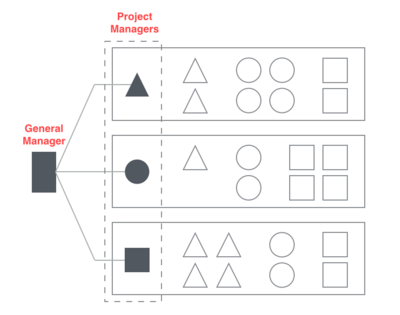Portfolio Management in a Startup
(→Background) |
|||
| Line 3: | Line 3: | ||
==Background== | ==Background== | ||
| − | A Startup can be seen as a business venture conceived to grow rapidly. In Product Development Startups, this potential growth is strongly | + | A Startup can be seen as a business venture conceived to grow rapidly. In Product Development Startups, this potential growth is strongly related to speed-to-market, as |
| − | Even that Startups' organisation is, by genetics, very flexible and adaptable to changes, a common shared | + | Even that Startups' organisation is, by genetics, very flexible and adaptable to changes, a common shared factor in different types of Startups is certainly the lack of resources. It can be in the shape of human, financial, material/equipment and/or knowledge resources, and CEOs need to handle this issue to enhance effective and efficient business processes. |
[[File:project-based-org.png|none|400px|thumb|left|Figure 1: Project Based Organisational Structure]] | [[File:project-based-org.png|none|400px|thumb|left|Figure 1: Project Based Organisational Structure]] | ||
| − | Historically, startups organisational structure has been characterised by a Project Oriented organisation, where | + | Historically, startups organisational structure has been characterised by a Project Oriented organisation, where |
| + | |||
==Limitations== | ==Limitations== | ||
==Conclusions== | ==Conclusions== | ||
==References== | ==References== | ||
Revision as of 23:55, 13 September 2015
Startups focused on Product Development that have a relatively wide product/project portfolio need to deal with scarce resources allocation. This issue is not trivial, as the lack of resources can lead to bottlenecks in the development phases, which are crucial for the survival of the Startup. This article aims to make a selection of the Agile methods, tools and organisational structures that best suit early stage Startups, specially those focused on Product Development.
Contents |
Background
A Startup can be seen as a business venture conceived to grow rapidly. In Product Development Startups, this potential growth is strongly related to speed-to-market, as
Even that Startups' organisation is, by genetics, very flexible and adaptable to changes, a common shared factor in different types of Startups is certainly the lack of resources. It can be in the shape of human, financial, material/equipment and/or knowledge resources, and CEOs need to handle this issue to enhance effective and efficient business processes.
Historically, startups organisational structure has been characterised by a Project Oriented organisation, where
